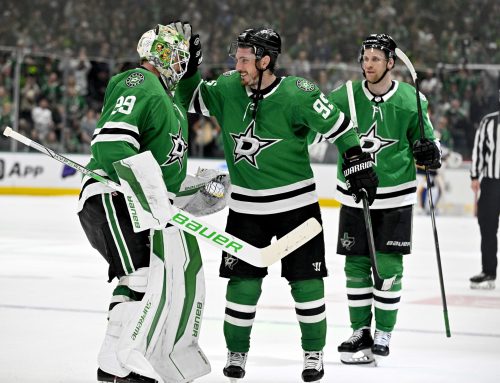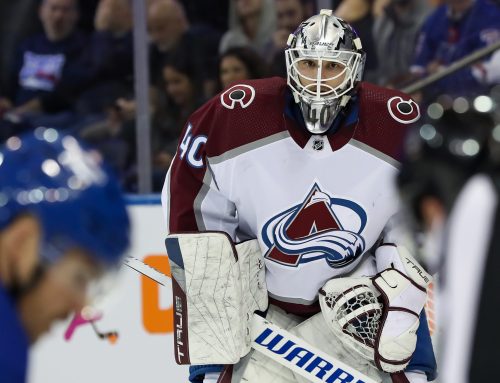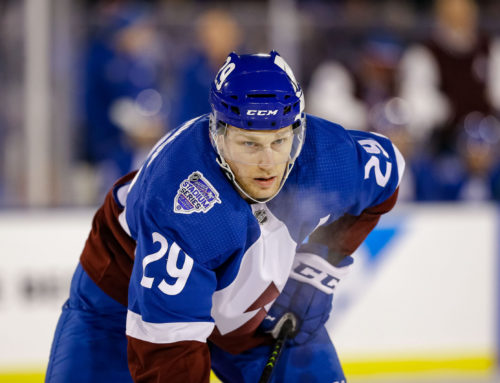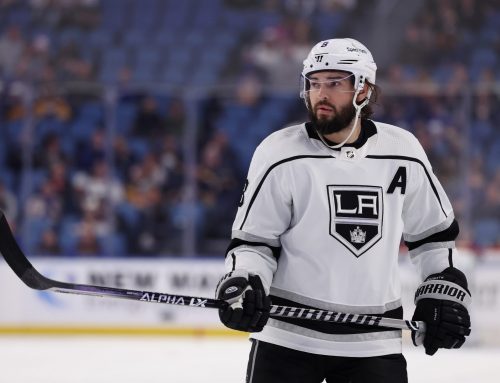Six Western Conference Players Bound to Decline
Doran Libin
2016-09-19
Six Western Conference players who are bound to decline this season…
This week we’ll start with Patrick Kane, as he is the surest bet to decline this year – but nobody should care. Writing about Kane in this column would not, and should not, change anyone’s mind about him. Kane could decline by 20 points and still be in the thick of the competition for the Art Ross. That being the case it does not matter in the least whether Kane will decline unless the expected decline is by 40 points. That is the only way his overall value will be affected.
The decline of the players on this list should have the potential of negatively impacting their value in a big way. The factors leading to a player getting a spot on this list are the same as the factors that in last week’s column of players set for a rebound.
Honorable Mentions:
Anthony Duclair and Max Domi are not going to suffer major declines, which is the reason they end up as honorable mentions. Domi and Duclair started by far the most shifts in the offensive zone of any player who was on the Coyotes all season. Domi started more than 55% of his even strength shifts in the offensive zone while Duclair started more than 60%. With the Coyotes set to feature a rookie as the center on their second line it is highly unlikely that Domi and Duclair will see the same usage. No one else on the team routinely saw more than 50% offensive zone starts and that includes Martin Hanzal the likely top-line center. Furthermore, the Coyotes let go of Boyd Gordon and Kyle Chipchura, their two big defensive workhorses. Gordon started 25% of his shifts in the offensive zone while Chipchura started just over 35%. The center in line to take on the fourth line is Tyler Gaudet, who, while capable of playing heavy defensive minutes, is another rookie and it is hard to see Dave Tippett using him in the same fashion as he used Gordon.
The point is that Tippett will need his other experienced lines to take on some of the defensive burden. That means that Domi and Duclair are going to see a major change in their offensive zone start percentage of around five and 10 percentage points respectively. That will make it harder for them to score. Duclair, and his 18% shooting percentage, is the most likely to decline but neither is likely to decline by more than five points.
After that novel on Duclair and Domi comes Bryan Little. He finds himself on the list because of the emergence of Mark Scheifele and because, SPOILER ALERT, Blake Wheeler is not hitting 78 points again. The Jets need to get Scheifele more offensive minutes and more minutes on the power play. Little is the obvious choice to lose the minutes that go to Scheifele. In the end the decline will not be huge, basically a point for every 10 games Little plays, which means he will struggle to hit 50 points this year as he has only played more than 75 games once in the last four full seasons.
There aren't many reasons to believe that Soderberg will decline this year other than the team-wide shot and scoring-chance rate freefall that most of the team experienced. Neither Soderberg’s personal nor on-ice shooting percentages are off base in any way. His personal shooting percentage is a little low, but it has been for each of the last two years. But the first issue is that the Avalanche have three centers who average 18 minutes per game or more with relatively little overlap other than between Matt Duchene and Nathan MacKinnon. Add in John Mitchell playing more than 13 minutes per game and that is nearly 70 minutes for Colorado’s four centers. With MacKinnon and Duchene being underutilized and Roy having left the building, it appears that one of the centers is going to lose some minutes. That center will likely be Soderberg. It will not be a huge decline for Soderberg but it will take him down closer to 45 than 55.
Alex Ovechkin was the only forward who played more minutes on the power play than Mikkel Boedker last season. To that end Boedker was one of only six players to have played more than 300 minutes on the power play. He was the only one of those players to score less than four points per 60 minutes on the power play. Those are not the type of numbers that scream this player deserves the same number of PP minutes while on a deeper team. The Sharks, Boedker’s new team, had four players get over 200 minutes on the power play, with Couture falling short because he missed more than 20 games. All of those players scored at least a point more per 60 minutes on the power play than did Boedker. In fact three Sharks players on their second unit also scored more points per 60 on the power play than Boedker. As such there is little reason to believe that Boedker gets significant power-play minutes on the Sharks. Given that 40% of Boedker’s production came on with the man advantage, this is a major cause for concern and a 10-point drop there is entirely reasonable.
A huge part of the reason that Wheeler was able to basically maintain a point-per-game pace over the course of the entire season was the run he and Mark Scheifele went on late in the year. Both of the most common line combinations featuring Wheeler and Scheifele had on-ice shooting percentages over 11%. Furthermore, Wheeler assisted on more than 50% of the Jets goals when he was on the ice for only the second time in the last eight years. As a result, he was involved in more 80% of the Jets goals scored when he was on the ice for the third time in eight years. These factors make it hard to see Wheeler coming close to 80 points for a second consecutive year. Take him from the upper echelon on first liners to something closer to the middle, except in multi-category leagues where his peripheral stats provide a boost.
Beauchemin hit 34 points last year, which was good for 10 more points than he had in any of the previous four seasons. That was good for the second best season of his career and only the second time in his career that he broke 30 points. For the first time in seven years Beauchemin was involved in 40% of the goals Colorado scored while he was on the ice. He had has only been involved in more than 30% of the goals scored when he was on the ice twice in the last seven years, making it seem unlikely that he will do it for the fourth time in five years. Beauchemin rate of involvement in the Avalanche’s offense when he was on the ice was amongst the top 50 defensemen in the league, he is not one of the 50 best offensive defensemen. There are more concerns around Beauchemin in that the shot- and scoring-chance rates for the Avalanche, as well as the goal rate when he is on the ice have been in freefall for the last three years. Those numbers could change with a new coach but a huge shift seems unlikely. That is not even the most troubling factor with Beauchemin, that goes to his primary assist rate of 0.08 per 60 minutes. To that end only two of his 13 assists at even strength were primary in nature. Expect Beauchemin to fall back under the 25-point mark this season.
Seabrook almost hit 50 points last year after only hitting 40 points once in the previous four seasons. His career year was based almost entirely on increased power play production, beating his previous career high by five, and doubling his career average. Furthermore, Seabrook managed 24 points at even strength despite more often than not being on the wrong end of the shot balance. For the first time in his career The Blackhawks faced more shots against than they took themselves with Seabrook on the ice. With the signing of Brian Campbell, that should change as Seabrook will get to play with one of Duncan Keith or Seabrook, two high-end play drivers. The signing of Campbell could have conflicting effects on Seabrook. It should help him at even strength but it gives Quenneville another legitimate option on the power play. In previous seasons, when he had such an option, Seabrook played between 35 and 45% of the Blackhawks power play minutes, last year he played over 55%. Seabrook also has conflicting shooting percentages. His on-ice shooting percentage was low while his personal shooting percentage was amongst the highest of his career. Part of the reason for the Hawks low on-ice shooting percentage with Seabrook on the ice is because their scoring chance rate was down by two per 60 minutes and their expected goal rate was down by half a goal per 60 minutes from the previous year and by almost three quarters of a goal from 2013/14. Seabrook has only hit five points per 60 minutes on the power play twice in his career, one of those times being last year, and with Campbell coming in is unlikely to hit that rate again. Look for Seabrook to be back around the 40-point mark.
Rinne has actually been in decline for a number of years now. He really does not belong on this list because if he declines much more he will barely even be a replacement level goalie. In three of the last four years Rinne has had a below average save percentage. Last year he put in a quality start in less than 50% of his starts, 60% is the mark of a high-end starter. Rinne has not even turned in quality starts in 55% of his games in three of the last four years. While the Subban-Weber trade is largely a positive one for the Predators it could have a negative effect on Rinne. While Subban’s effect on driving play is much better than Weber’s the same cannot be said for quality of shot and expected goals. Weber gives up shots but he has a positive effect, meaning a lower relative scoring chance against rate and expected goals against rate, on the number of scoring chances his team gives up and his team’s expected goals against per 60 minutes. Basically Weber allows more shots but effectively limits the quality of shots against. Rinne struggles on shots from 1 to 15 feet (77.5%) as well on shots from 16 to 30 feet (88.2%). On shots from both those ranges Rinne is five points below average, which is more than a little scary. In short, dump Rinne now, it should only get worse.
The statistics in this column were drawn from the reports and player profiles at Dobberhockey.com as well as from stats.hockeyanalysis.com, Corsica.hockey and hockey-reference.com.
10 Comments
Leave A Comment
You must be logged in to post a comment.





 NYI
NYI CAR
CAR T.B
T.B FLA
FLA TOR
TOR BOS
BOS VGK
VGK DAL
DAL EDM
EDM WSH
WSH L.A
L.A VAN
VAN WPG
WPG NYR
NYR NSH
NSH BUF
BUF CBJ
CBJ

So Seabrook could spend a lot of time playing with himself?
Hockey players do spend a lot of time on the road…
& hear I thought Ryan White had been brought in to be the #4 C for Arizona. I don’t even see Gaudet on Arizona’s roster even if significant injuries hit. Depending upon how many rookies are added to Arizona this year Richardson could even slide from the #3 C spot to #4.
Not that any of this matters from a fantasy perspective.
Ryan White played mostly on the wing in Philly although he did take draws. I mixed up my Coyote prospects, I meant Laurent Dauphin but the point remains the same. I can’t see Tippett running with 2 offensively minded rookie centers. Dauphin is a defense-first centers who even takes draws the same way the Bird Gordon does, namely dropping to his knees making sure to limit the other centers options. For a defensive minded coach like Tippett Dauphin makes more sense than anyone else in the system.
This is what I see currently for Arizona.
Domi, Hanzal, Duclair.
McGinn, Strome, Vrbata.
Dvorak, Richardson, Domi.
Martinson, White, Reider.
Having Dauphin sit at 21 years of age as the primary spare or 13th forward at least until injures hit doesn’t make sense to me. He needs to play to continue to develop. I think Chris Mueller has a far better chance of serving as the 13th forward. Again until at least injures open up a roster spot.
Now should Dvorak not be ready which would shock me, he was 1 of the most complete 2 way players in Major Jr last season then it’s possible that Richardson could slide to RW, Doan to left & a C spot open up for Dauphin. I’m not sure dauphin is NHL ready yet.
You’ve got Domi on there twice, so there’s another spot available.
Sorry the #3 RW is supposed to be Doan.
I thought someone important was missing. No extra spaces now lol.
I think your 3rd line is incorrect. The Richardson-Doan-Martinook line has negative relative numbers for shots against, expected goals against, scoring chances against and goals against per 60 minutes. That means the Coyotes allow less of each of those when that line is on the ice than when they aren’t. All that despite having hugely negative relative zone starts, meaning that they start for the most part in the defensive. Richardson isn’t moving to the wing because the Coyotes are already pretty deep on the wing even without Rieder signed. Dauphin between White and somebody, Rieder if he signs, gives the Coyotes the best shot at a defensively responsible fourth line. Tippet is a defensive minded coach, he isn’t going to sacrifice defense by going with inexperienced rookies throughout the lineup. He could go with Domi and Duclair last year because the bottom 6 was filled with defensive minded veterans. Remember that he benched Duclair for a stretch last year because he was unhappy with his defensive game. It makes it unlikely that he goes with 2 rookies this year when he will already need to rely more Domi and Duclair defensively, in a manner he didn’t have to last year when his 2nd line center was Vermette for most of the season. Furthermoe, in the less than 100 minutes that Dauphin played he was a negative offensively but also quite good defensively, although he did have a positive relative zone start percentage. Dauphin may be 21 but he makes the most sense for the fourth line.
I guess a lot will depend on if Dvorák makes the team. Nor do I expect any combination to stay in place for every minute of all 82 games if everyone could stay healthy. Bodies will move around.
Nor do I like the possibility of Reider being deployed on a 4th line.
It’s just an educated guess based on a whole range of issues. Time will tell if our assumptions are or are not correct.
I like your logic but I also factor in the business side of the game. Waiver rights, etc. Pedigree, scoring need etc.